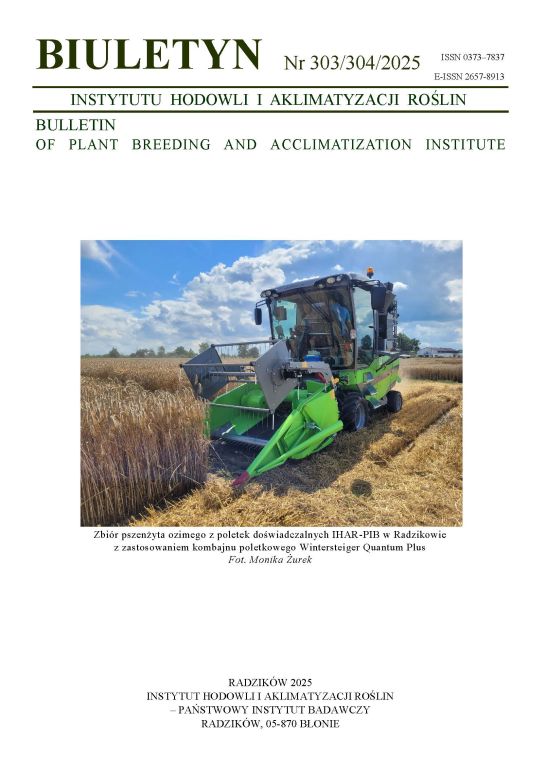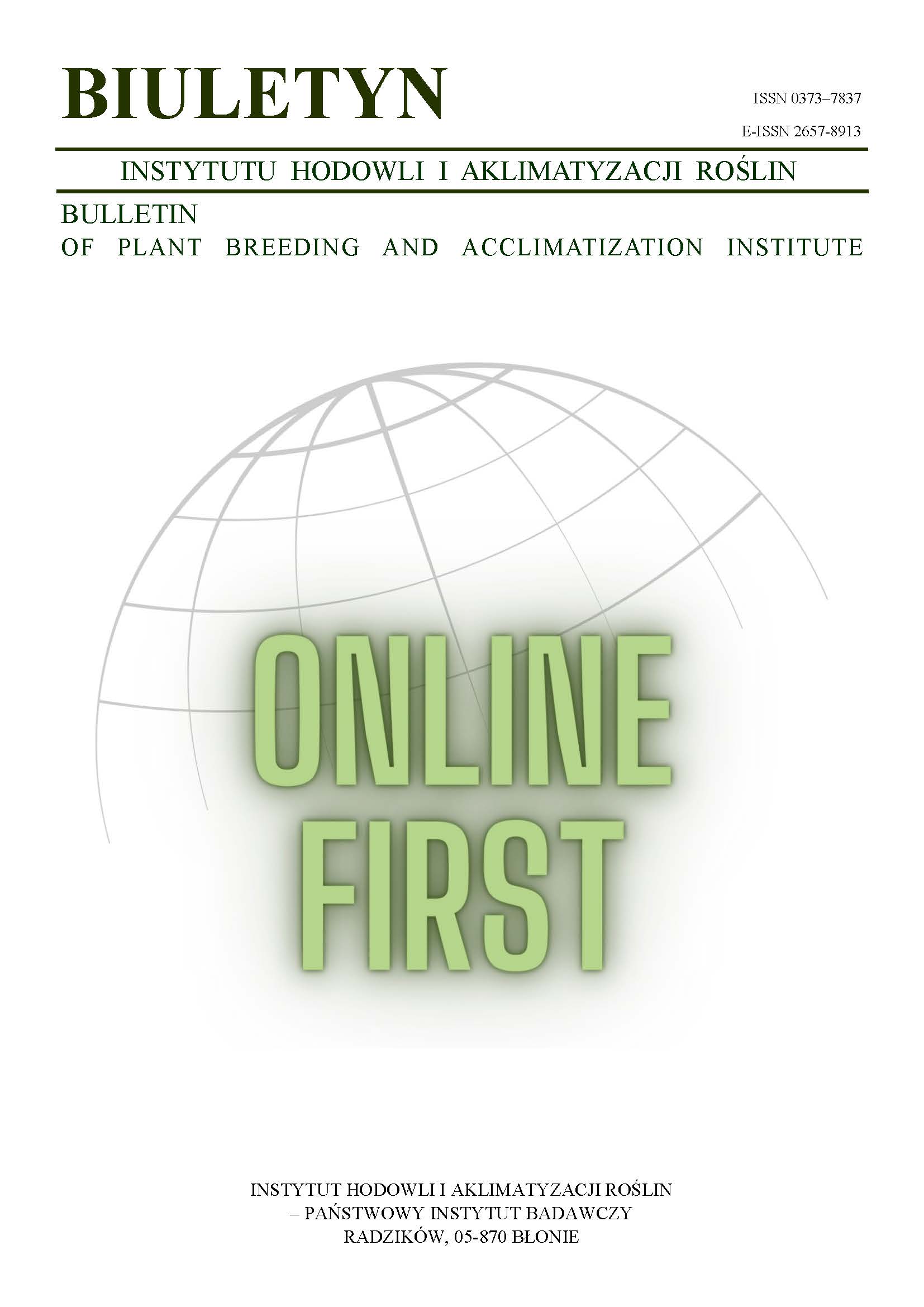Ocena właściwości reologicznych ciasta i jakości chleba pszennego z dodatkiem śruty owsianej
Anna Czubaszek
dziekanat.wbinoz@upwr.edu.plKatedra Technologii Owoców, Warzyw i Zbóż, Akademia Rolnicza, Wrocław (Poland)
Abstrakt
Materiał badawczy stanowiła handlowa mąka pszenna typu 550 i ziarno 6 odmian owsa (Akt, Bajka, Borowiak, Chwat, Cwał, Kasztan). Wykonano analizy mające na celu scharakteryzowanie materiału badawczego oraz przeprowadzono oznaczenia farinograficzne, ekstensograficzne i wypiek laboratoryjny ciasta z udziałem 5 i 10% śruty owsianej. Mąka pszenna typ 550 charakteryzowała się dobrą wartością wypiekową. Odmiany owsa zawierały dużo białka ogółem oraz mało skrobi, pentozanów i popiołu. Odznaczały się one wysoką aktywnością enzymów proteolitycznych i liczbą opadania. Dodatek śruty owsianej do mąki pszennej powodował zwiększenie wodochłonności mieszanek, a wraz ze wzrostem ilości śruty wydłużał się czas rozwoju, skracał czas stałości ciasta i zwiększała wartość współczynnika tolerancji na mieszenie. Ciasta z dodatkiem 5% śruty owsianej miały największą wartość walorymetryczną. Stwierdzono, że spośród wszystkich badanych ciast pszenno-owsianych najlepsze właściwości farinograficzne miały ciasta z udziałem śruty z odmian Bajka i Chwat. W ocenie ekstensograficznej uzyskano pogorszenie jakości ciasta pod wpływem dodatku śruty owsianej. Zaobserwowano zróżnicowane oddziaływanie odmian na właściwości ekstensograficzne przy różnym udziale śruty owsianej w mieszance. Przy dodatku 5% najlepsze rezultaty uzyskiwano ze śrutą z odmian Kasztan i Akt, a przy 10% ze śrutą odmiany Bajka. Chleb pszenno-owsiany był wyrośnięty i charakteryzował się przyjemnym aromatem. Chleb z dodatkiem 5% śruty owsianej miał nieznacznie większą objętość niż chleb pszenny, a z 10% udziałem był najmniejszy. Największe były chleby zawierające śrutę owsianą z odmian Cwał i Borowiak. Nadpiek chleba nie ulegał zmianom pod wpływem stosowanych dodatków. Zastąpienie mąki pszennej dodatkiem 10% śruty owsianej spowodowało poprawę struktury miękiszu chleba.
Słowa kluczowe:
ekstensograf, farinograf, mieszanki pszenno-owsiane, wypiek chlebaBibliografia
AACC 2000. American Association of Cereal Chemists. Approved Methods of the AACC. St. Paul M. N.
Google Scholar
Axford D. W. E., Mc Detmott E. E., Retman D. G. 1979. Note on the sodium dodecyl sulfate test of breadmaking quality. Comparison with Pelshenke and Zeleny test. Cereal Chem. 56 (6): 582 — 584.
Google Scholar
Bartnikowska E., Lange E. 2000. Znaczenie dietetyczne przetworów owsianych i ich wpływ na stężenie cholesterolu w osoczu oraz poposiłkową glikemię. Żywność. Nauka. Technol. Jakość. 1: 18 — 36.
Google Scholar
Bartnikowska E., Lange E., Rakowska M. 2000. Ziarno owsa — niedoceniane źródło składników odżywczych i biologicznie czynnych. Cz. I. Ogólna charakterystyka owsa. Białka, tłuszcze. Biul. IHAR 215: 209 — 221.
Google Scholar
Boyacioğlu M. H., D’Appolonia B. L. 1994. Characterization and utilization of durum wheat for breadmaking. Comparison of chemical, rheological and baking properties between bread wheat fours and durum wheat flours. Cereal Chem. 71: 21 — 28.
Google Scholar
Czubaszek A. 2003. Wybrane cechy fizyczne i skład chemiczny ziarna kilku odmian owsa. Biul. IHAR 229: 307 — 315.
Google Scholar
Dolatowski Z. J., Stasia D. M., Pisarek S. 2002. Wpływ obróbki hydrotermicznej ziarna owsa na jego wybrane właściwości fizyczne. Acta Sci. Pol. Technologia Alimentaria 1: 91 — 102.
Google Scholar
Gambuś H., Gibiński M. 2003. Wpływ dodatku skrobi owsianej na jakość i starzenie się pieczywa pszennego. Biul. IHAR 229: 291 — 299.
Google Scholar
Gawęcki J., Hryniewski L. 2000. Żywienie człowieka. Podstawy nauki o żywieniu. Wyd. Nauk. PWN, Warszawa.
Google Scholar
Gąsiorowski H. 1995. Owies — chemia i technologia. PWRiL, Poznań.
Google Scholar
Gibiński M. 2000. Chemical composition of the selected varieties and strains of oat. Żywność. Nauka. Technol. Jakość. 2 (23), Supl.: 84 — 91.
Google Scholar
Halfrisch J., Behall K.M. 2003. Physiological responses of men and women to barley and oat extracts (Nu - Trim X). I. Breath hydrogen, methane and gastrointestinal symptoms. Cereal Chem. 80: 76 — 79.
DOI: https://doi.org/10.1094/CCHEM.2003.80.1.76
Google Scholar
Halfrisch J., Scholfield D. J., Behall K. M. 2003. Physiological responses of men and women to barley and oat extracts (Nu-Trim X). II. Comparison of glucose and insulin responses. Cereal Chem. 80: 80 — 83.
DOI: https://doi.org/10.1094/CCHEM.2003.80.1.80
Google Scholar
Kamińska B. Z., Koreleski J., Skraba B. 1999. Efekt obłuszczenia ziarna owsa oraz uzupełnienia paszy preparatem enzymatycznym na wyniki odchowu brojlerów. Żywność. Nauka. Technol. Jakość. 1 (18) Supl.: 231 — 239.
Google Scholar
Karolini-Skaradzinska Z., Subda H., Korczak B., Kowalska M., Żmijewski M., Czubaszek A. 2001. Ocena technologiczna ziarna i mąki wybranych odmian pszenicy ozimej. Żywność. Nauka. Technol. Jakość. 27 (2): 68 — 77.
Google Scholar
Kawka A., Gąsiorowski H. 1995. Produkty owsiane w piekarstwie. Przegl. Piek. Cuk. 5: 8 — 10.
Google Scholar
Korus J., Achremowicz B. 1994. Substancje stosowane do poprawienia jakości pieczywa (cz. I). Przegl. Piek. Cuk. 2: 6.
Google Scholar
Krishnan P. G., Chang K. C., Brown G. 1987. Effect of commercial oat bran on characteristic and composition of bread. Cereal Chem. 64: 55 — 58.
Google Scholar
Kubiak W. 1995. Chrupiące bułeczki czy zdrowie? Zdrowa Żywność. 3 (29): 25 — 27.
Google Scholar
Lapveteläinen A., Puolanne E., Salovaara H. 1994. High-protein oat flour functionality assessment in bread and sausage. J. Food Sci. 59 (5):1081 — 1085.
DOI: https://doi.org/10.1111/j.1365-2621.1994.tb08195.x
Google Scholar
Lapveteläinen A., Alho-Lehto P., Sinn L., Laukkanen T., Lindman T., Kalio H., Kaitaranta J., Katajisto J. 2001. Relationships of selected physical, chemical and some sensory parameters in oat grain, rolled oats, cooked oat meal – a three year study with eight cultivars. Cereal Chem. 78: 322 — 329.
DOI: https://doi.org/10.1094/CCHEM.2001.78.3.322
Google Scholar
Lee C. J., Horsley R. D., Manthey F. A., Schwartz P. B. 1997. Comparisons of β-glucan content of barley and oat. Cereal Chem. 74: 571 — 575.
DOI: https://doi.org/10.1094/CCHEM.1997.74.5.571
Google Scholar
Lue S., Hsieh F., Huff H. E. 1991. Extrusion cooking of corn meal and sugar beet fiber: Effects on expansion properties, starch gelatinization, and dietary fiber content. Cereal Chem. 68: 227 — 234.
Google Scholar
Maciejewicz-Ryś J., Sokół K. 1999. Wpływ L-lizyny lub preparatu enzymatycznego na wartość pokarmową białka owsa nagoziarnistego (Avena sativa var. Nuda) i oplewionego (A. sativa L.). Żywność. Nauka. Technol. Jakość. 1 (18) Supl.: 267 — 272.
Google Scholar
Magnus E. M., Bråthen E., Salstrøm S., Vogt G., Færgestad E. M. 2000. Effects of flour composition, physical dough properties and baking process on hearth loaf properties studied by multivariate statistical methods. J. Cereal Sci. 32: 199 — 212.
DOI: https://doi.org/10.1006/jcrs.2000.0325
Google Scholar
Michniewicz J., Biliaderis C. G., Bushuk W. 1991. Effect of added pentosans on some physical and technological characteristics of dough and gluten. Cereal Chem. 68: 252 — 258.
Google Scholar
Michniewicz J. 1995 a. Dodatki funkcjonalne stosowane w technologii piekarskiej. Przegl. Piek. Cuk. 9: 2 — 4.
Google Scholar
Michniewicz J. 1995 b. Pentozany w technologii zbóż. Rocz. AR w Poznaniu. Rozpr. Nauk. Zesz. 261.
Google Scholar
Oomah B. D. 1983. Baking and related properties of wheat-oat composite flours. Cereal Chem. 60: 220 — 225.
Google Scholar
Oomah B. D., Lefkovitch L. P. 1988. Optimal oxidant requirement of wheat-oat composite flours. Nahrung 32 (6): 527 — 538.
DOI: https://doi.org/10.1002/food.19880320602
Google Scholar
Peterson D. M. 2001. Oat antioxidants. J. Cereal Sci. 33: 115 — 129.
DOI: https://doi.org/10.1006/jcrs.2000.0349
Google Scholar
Piesiewicz H. 1996. Cholesterol a zdrowie. Przegl. Piek. Cuk. 6: 2 — 3.
Google Scholar
Pizło H., Bobrecka-Jamro D., Tobiasz-Salach R. 1999. Skład chemiczny nowych rodów owsa uprawianego w warunkach Beskidu Niskiego. Żywność. Nauka. Technol. Jakość. 1 (18) Supl.: 142 — 146.
Google Scholar
PN 2171. 1994. Ziarno zbóż i przetwory zbożowe. Oznaczenie popiołu całkowitego. Wyd. Normal.
Google Scholar
PN 74/A-74043-3:1994. Ziarno zbóż i przetwory zbożowe. Oznaczanie glutenu mokrego. Mąka pszenna. Wyd. Normal.
Google Scholar
PN-ISO:3093:1996. Zboża. Liczba opadania. Wyd. Normal.
Google Scholar
Rocznik Statystyczny 2003. GUS. Wyd. Statyst., Warszawa.
Google Scholar
Subda H. 1984 a. Instrukcja wdrożeniowa oznaczania aktywności enzymów proteolitycznych. Biul. IHAR 152: 139 — 141.
Google Scholar
Subda H. 1984 b. Metoda oznaczania zawartości pentozanów rozpuszczalnych w wodzie (instrukcja). Biul. IHAR 155: 325 — 326.
Google Scholar
Subda H., Karolini-Skaradzińska Z., Czubaszek A., Gil Z. 1998 a. Skład chemiczny kilku polskich odmian owsa. Biul. IHAR 208: 103 — 109.
Google Scholar
Subda H., Karolini-Skaradzińska Z., Czubaszek A. 1998 b. Skład chemiczny i wartość technologiczna wybranych odmian owsa. Biul. IHAR 208, 111 — 121.
Google Scholar
Wang J., Rosell C. M., Benedito de Barber C. 2002. Effect of the addition of different fibers on wheat dough performance and bread quality. Food Chem. 79: 221 — 226.
DOI: https://doi.org/10.1016/S0308-8146(02)00135-8
Google Scholar
Zhang D., Moore W. R., Doehlert D. C. 1998. Effect of oat grains hydrothermal treatments on wheat-oat flour dough properties and breadmaking quality. Cereal Chem. 75: 602 — 605.
DOI: https://doi.org/10.1094/CCHEM.1998.75.5.602
Google Scholar
Zhou M., Robards K., Glennie-Holmes M., Helliwell S. 1998. Structure and pasting properties of oat starch. Cereal Chem. 75: 273 — 281.
DOI: https://doi.org/10.1094/CCHEM.1998.75.3.273
Google Scholar
Autorzy
Anna Czubaszekdziekanat.wbinoz@upwr.edu.pl
Katedra Technologii Owoców, Warzyw i Zbóż, Akademia Rolnicza, Wrocław Poland
Statystyki
Abstract views: 57PDF downloads: 34
Licencja
Prawa autorskie (c) 2006 Anna Czubaszek

Utwór dostępny jest na licencji Creative Commons Uznanie autorstwa – Na tych samych warunkach 4.0 Miedzynarodowe.
Z chwilą przekazania artykułu, Autorzy udzielają Wydawcy niewyłącznej i nieodpłatnej licencji na korzystanie z artykułu przez czas nieokreślony na terytorium całego świata na następujących polach eksploatacji:
- Wytwarzanie i zwielokrotnianie określoną techniką egzemplarzy artykułu, w tym techniką drukarską oraz techniką cyfrową.
- Wprowadzanie do obrotu, użyczenie lub najem oryginału albo egzemplarzy artykułu.
- Publiczne wykonanie, wystawienie, wyświetlenie, odtworzenie oraz nadawanie i reemitowanie, a także publiczne udostępnianie artykułu w taki sposób, aby każdy mógł mieć do niego dostęp w miejscu i w czasie przez siebie wybranym.
- Włączenie artykułu w skład utworu zbiorowego.
- Wprowadzanie artykułu w postaci elektronicznej na platformy elektroniczne lub inne wprowadzanie artykułu w postaci elektronicznej do Internetu, lub innej sieci.
- Rozpowszechnianie artykułu w postaci elektronicznej w internecie lub innej sieci, w pracy zbiorowej jak również samodzielnie.
- Udostępnianie artykułu w wersji elektronicznej w taki sposób, by każdy mógł mieć do niego dostęp w miejscu i czasie przez siebie wybranym, w szczególności za pośrednictwem Internetu.
Autorzy poprzez przesłanie wniosku o publikację:
- Wyrażają zgodę na publikację artykułu w czasopiśmie,
- Wyrażają zgodę na nadanie publikacji DOI (Digital Object Identifier),
- Zobowiązują się do przestrzegania kodeksu etycznego wydawnictwa zgodnego z wytycznymi Komitetu do spraw Etyki Publikacyjnej COPE (ang. Committee on Publication Ethics), (http://ihar.edu.pl/biblioteka_i_wydawnictwa.php),
- Wyrażają zgodę na udostępniane artykułu w formie elektronicznej na mocy licencji CC BY-SA 4.0, w otwartym dostępie (open access),
- Wyrażają zgodę na wysyłanie metadanych artykułu do komercyjnych i niekomercyjnych baz danych indeksujących czasopisma.
Inne teksty tego samego autora
- Anna Czubaszek, Wybrane cechy fizyczne i skład chemiczny ziarna kilku odmian owsa , Biuletyn Instytutu Hodowli i Aklimatyzacji Roślin: Nr 229 (2003): Wydanie specjalne














